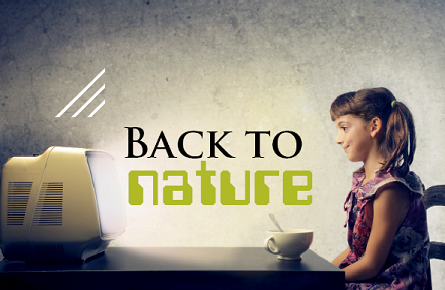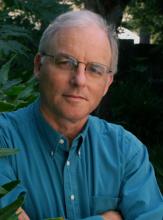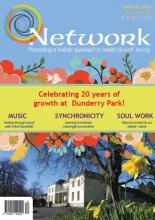Back to Nature: Understanding Nature Deficit Disorder
by:
Network Ireland
Published:
Tuesday, July 16, 2013

Richard Louv is a journalist and author of eight books about the connections between family, nature and community, including the best-selling Last Child in the Woods: Saving our children from Nature-Deficit Disorder. His latest book, The Nature Principle offers a new vision of the future in which our lives are as immersed in nature as they are in technology. This future, available to all of us right now, offers better psychological, physical and spiritual health for people of every age. Richard talks to Network about Nature Deficit Disorder, finding the balance between nature and technology, how we can better integrate nature into our lives and homes, and the benefits we can find by doing so.
Understanding Nature Deficit Disorder
"Nature-deficit disorder" as I defined it in Last Child in the Woods, is not a medical diagnosis, but a useful term to describe the human costs of alienation from nature, as suggested by recent research. Among these costs are diminished use of the senses, attention difficulties, higher rates of physical and emotional illnesses, a rising rate of myopia, child and adult obesity, and other maladies.
This disorder damages children – and, as I write about in The Nature Principle, adults as well — but I think of it as more of a disorder of the society. This disorder also shapes adults, families, whole communities, and the future of our stewardship of nature. Studies show that people who care deeply about the future of the environment almost always enjoyed transcendent experiences in nature when they were children. If nature experiences continue to fade from the current generation of young people, and the next, and the ones to follow, where will future stewards of the earth come from?
The disconnect with nature is associated with two trends: one is the fading of independent play, which is linked directly to what psychologists call “executive function,” the ability to self-control; and to what medical experts are now calling the “pandemic of inactivity.”
In January, 2013, the Harvard Business Review published Sitting is the Smoking of Our Generation, an article by Nilofer Merchant, a former founder and CEO of Rubicon. “As we work, we sit more than we do anything else.” Add in the time we sit at home, and we’re averaging over 9 hours of sit time every day.
And as for how this effects children, well just think of schools. Some do a good job getting kids moving. But at other schools, too many students spend most of their time sitting. At their desks, in front of computers, taking tests, sitting in schools where recess and gym class have been restricted or eliminated. Even in preschools, most children sit in the classroom for most of the day — and even when they go outside, more than half of their activities remain sedentary. Then they sit in a car to be driven home to sit some more.
The greatest cost, it seems to me, is a stunted ability to feel and be fully alive. I’m not anti-tech, but I do believe this: The more high-tech our lives become, the more nature we need. We need nature experience as an antidote to some of the downsides of technological influences, and we need to nature to revive the full use of the human senses – conservatively ten and as many as thirty senses, according to some scientists. As we focus for hours on our screens, we spend much of our time trying to block out most of those senses. To me, that’s a definition of being less alive. What parent wants their child to be less alive? What adult wants to be less alive? Some do, but most of us want something better.
Living Walls or Vertical Gardens are becoming increasingly popular features in new developments, but the basic concept can also be affordably implemented to bring some green into any space as demonstrated by Dave Upshaw - for step by step instructions on how to create this visit his blog beersnbeans.blogspot.ca
Balancing Technology and Nature
In The Nature Principle, I include a section on what I call “techno-naturalists.” I point out that taking technology with us into nature isn’t new. A fishing rod, a compass, binoculars are examples of technologies we’ve used for nature exploration. Today, the family that goes geocaching or wildlife photographing with their digital cameras is doing something as legitimate as backpacking; these gadgets offer an excuse to get outside.
The attitude of young citizen naturalists toward technology is bound to be different from that of many older people — and that could be an advantage. However, I’m not keen on the kind of gadgets that go over the line — to the point where we become more aware of the gadget than of nature; iPod-guided tours of natural areas, for example, offer audio information at the cost of the use of many other senses. The litmus test for some of this technology should be how long it takes for someone to look up from the screen, or forget the gadget, and actually experience nature, and to feel a sense of wonder.
Another test is whether the technology is preventing other people from fully experiencing nature. Loud engines don’t pass that test.
Living Connected to Nature
People who want to maximize the restorative powers of nature in their homes and urban neighbourhoods are developing fascinating approaches to daily life, from creating “living walls” and using natural elements within their homes, to creating healing gardens and wildlife sanctuaries in their yards. The home nature-restoration market is growing. One company produces indoor “living walls” of ficus, hibiscus, orchids and other plants.
A backyard revolution is brewing, based on the belief that the last best hope for biodiversity is in our own yards and home garden, which if transformed using native species could bring back bird and butterfly migrations – and at the same time be restorative to human health and well-being. These are just a few examples.
We need to realize that even in densely urban settings, nature can often be found nearby, somewhere in the neighbourhood. This is partly a design issue, but it’s also about intent. Getting kids outside needs to be a conscious act on the part of parents or caregivers. I suggest that over-scheduled families make outdoor time a priority. As parents, grandparents, aunts or uncles, we can spend more time with children in nature. To do so, we need to schedule nature time. This is quite a challenge, one that emphasizes the importance of exploring nearby opportunities. This proactive approach is simply part of today’s reality.
As of 2008, more people live in cities than in the countryside in the whole world. This is a huge and largely unremarked moment in human history, and it means one of two things: either the human connection to nature will continue to disintegrate – or we’ll work to create a new kind of city, one with new kinds of workplaces and homes that actually connect people to nature, one in which cities become incubators of biodiversity.
It seems that some older cultures are more aware of the sacredness of nature, and that we have much to learn. I should say here, too, that some of us need to think differently about how different ethnic or cultural groups relate to nature. In The Nature Principle, I write about what I call “natural cultural capacity,” the historic nature-based strengths that have been under-reported and underappreciated in, for example, African-American, Hispanic, and other communities — including indigenous cultures.
The human spirit is inseparable from the natural world. As the eco-theologian Thomas Berry wrote, “A degraded habitat will produce degraded humans.” The concept of an “ecological unconscious” has emerged at the crossroads of science, philosophy and theology. This is the idea that all of nature is connected in ways that we do not fully understand.
After Last Child in the Woods was published, I was surprised that so many religious figures, on the right and the left, were supportive of it. I came to the conclusion that they intuitively understand that all spiritual life begins with a sense of wonder. Nature is our most immediate, shared window into wonder. This is not only a view into the past but into a potential new era. I avoid the phrase “back to nature.” I prefer to say, “Forward to nature.”
Moving Forward to Nature
I do see progress, but I don’t see enough yet. In recent years we’ve seen much greater awareness and action. Shortly after Last Child in the Woods was published, several of us formed a non-profit, the Children & Nature Network which offers many ways that we can connect our children, families and communities to nature – and it is a good source of the latest news and research on the deficit and the benefits.
We’ve seen the emergence of major campaigns to connect children and the rest of us to nature, in the U.S. and around the world. We’ve also seen how the issue of nature-deficit disorder can bring people together across political, religious and generational lines. We can agree that our children’s nature deficit, and our own, can drain life and spirit from the human experience.
I’ve been arguing for several years that a positive connection between humans, especially children, and the rest of the natural world should be considered a human right.
In September 2012, the World Congress of the International Union for the Conservation of Nature (IUCN) cited “adverse consequences for both healthy child development (‘nature deficit disorder’) as well as responsible stewardship for nature and the environment in the future,” and then passed a resolution titled “The Child’s Right to Connect with Nature and to a Healthy Environment.”
This connection is, indeed, a human right. And the acknowledgement of that is progress.
About the author:
 Richard’s best-selling book Last Child in the Woods and his latest work The Nature Principle are available from shops now.
Richard’s best-selling book Last Child in the Woods and his latest work The Nature Principle are available from shops now.richardlouv.com
childrenandnature.org
Latest Issue
Upcoming Events
-
17/04/2020 to 26/04/2020
-
18/04/2020
-
23/04/2020
-
15/05/2020 to 23/05/2020
-
16/05/2020 to 17/05/2020
Recent Articles
Article Archive
- November 2012 (3)
- December 2012 (1)
- January 2013 (7)
- February 2013 (6)
- March 2013 (7)
- April 2013 (7)
- May 2013 (7)
- June 2013 (3)
- July 2013 (7)
- October 2013 (2)


